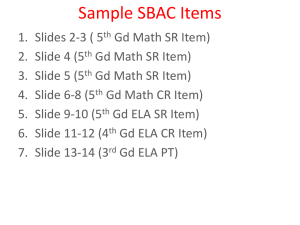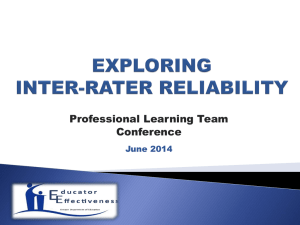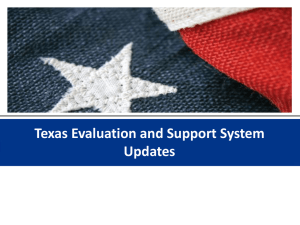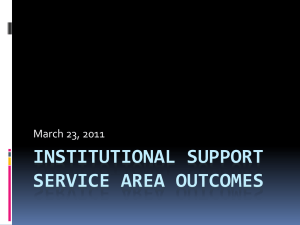Lead Evaluator for Principals Presentation
advertisement
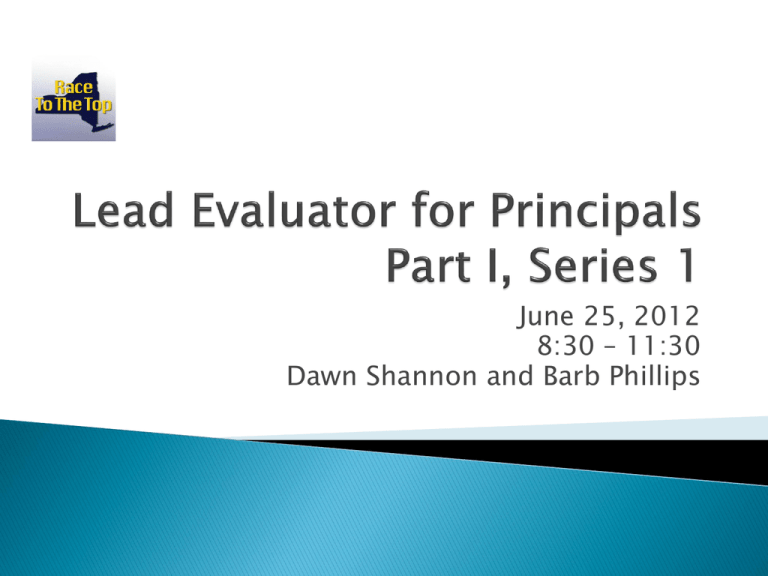
June 25, 2012 8:30 – 11:30 Dawn Shannon and Barb Phillips Define the required components of lead evaluator training for principal evaluation Describe the decisions your district has negotiated about the principal APPR Identify options for districts based on APPR decisions described by other districts. Explain the decisions made by your district regarding the “evidence collection” process for the 60 points based on the rubric. Define the types of evidence that could be gathered during school visits. Define the regulations regarding goal setting. Describe how “informal goal setting” might assist districts in data collection process. Explain criteria for quality evidence and how this is used in principal evaluation Compare current practices with recommended practices. Describe the implications for your district. 1. 2. New York State Teaching Standards and/or ISLLC 2008 Evidence-based observation techniques 3. Use of the student growth percentile model and the value-added growth model 4. Use of rubric(s) selected by the district used for evaluation 5. Use of any other assessment tools used to evaluate, including, but not limited to: structured portfolio reviews; student, parent, teacher and/or community surveys; professional growth goals and school improvement goals, etc. 6. Use of locally selected measures of student achievement 7. Use of the Statewide Instructional Reporting System. 8. 9. The scoring methodology utilized to evaluate a teacher or principal, including how scores are generated for each subcomponent and the scoring bands (HEDI) Specific considerations in evaluating teachers and principals of English language learners and students with disabilities. 0 – 20* GROWTH 0 – 20* LOCAL 0 – 60 RUBRIC •State provided Growth Score* •Locally Selected measures of student achievement •Based on a state approved rubric Elementary/Middle ◦ Results of student growth measured by 4-8 ELA HS ◦ Results of principal student growth percentile as applied to State assessments and/or graduation rates OTHER? Does a principal need an SLO? SLO will be the other comparable growth measure in buildings in which fewer than 30% of students take 4-8 ELA, Math, and/or HS courses with state or Regents assessments. Elementary/Middle High School •Achievement levels on state tests (% proficient or advanced – ELA/Math 4-8 • Percent of cohort achieving specified scores on Regents exams ( or Regents-equivalents) •Growth or achievement for subgroups (SWD,ELL) on ELA/Math 4-8 •Graduation rates (4,5,6) or drop out rates •Growth or achievement of students in ELA/Math grades 4-8 at specific performance levels (i.e. Level 1) •Student Performance on any District-Wide locally-selected assessments approved in teacher evaluations •Graduation % with Advanced designation and/or honors •Credit accumulation or other strong predictor of progress toward graduation •Student Performance on any District-Wide locally-selected assessments approved in teacher evaluations What decisions has your district negotiated regarding the local 20%? Requirements: Multiple measures At least 31 of 60 points based on multiple school visits by supervisor, trained evaluator. At least one must be unannounced ANY remaining points based on goals ALL leadership standards must be addressed at least once a year 1. The first goal must be related to improving teacher effectiveness, based on: A. B. C. 2. Improved retention of high performing teachers Correlations of student growth scores to teachers granted vs. denied tenure Improvements in proficiency rating of the principal on specific teacher effectiveness standards in the rubric Any other goals must be quantifiable, verifiable improvements in academic results or the schools learning environment (i.e. student or teacher attendance) • Evidence of goals must include at least two of the following: Structured feedback from teachers, students, and/or families using a State-approved tool (each constituency is one source) School visits by OTHER trained evaluators Review of school documents or records NOTE: Multiple documents count as 1 source of evidence How can goals be helpful in the process of collecting evidence for the 60 points? Considerations for goal setting. . . What decisions has your district negotiated regarding the 60%? Which rubric? Which types of evidence? What are the characteristics of your rubric? How is it organized? How are the leadership strands defined? Observing a principal during a pre-conference, an observation, and a post conference Observing a principal during a team DDI/PLC meeting Observing a principal in a faculty meeting, community group meeting Observing a principal in a student group session/meeting Other. . . Select one context for collecting data in a visit. Describe what kind of evidence the evaluator would collect? What will the conditions for success be? What are qualities of effective evidence? Observable Accurate Representative Sufficient (remember: free of bias, opinion, not a summary) Select the part of your rubric that best aligns with ISLLC STANDARD 2: Advocating, nurturing, and sustaining a school culture and instructional program conducive to student learning and staff professional growth. ___________________________________________ Examine the smallest category (indicators, elements) that define the levels of excellence. What are the characteristics of the “proficient/effective” score? What are the differences between the effective and highly effective? Effective and developing? What would be examples of EVIDENCE for each? Select the part of your rubric that best aligns with STANDARD 3: Ensuring management of the organization, operation, and resources for a safe, efficient, and effective learning environment ___________________________________________ Examine the smallest category (indicators, elements) that define the levels of excellence. What are the characteristics of the “proficient/effective” score? What are the differences between the effective and highly effective? Effective and developing? What would be examples of EVIDENCE for each? How is this system of evaluation different from current practice in your district? What structures will you need to have in place to ensure that this evaluation process is successful? At the next session, we will. . . Evaluate examples of evidence, justify the quality of the evidence, and categorize the evidence on the rubric Thank you! We appreciate the opportunity to work with you today! Please take a moment to give us feedback! We will see you again on July 2! Dawn and Barb


